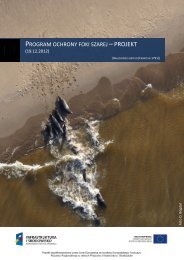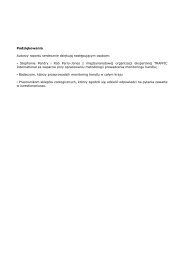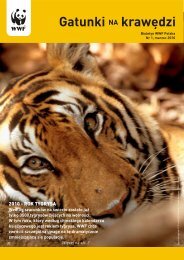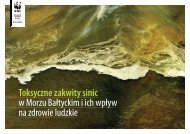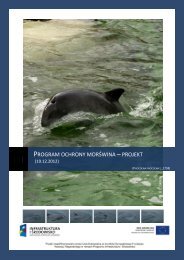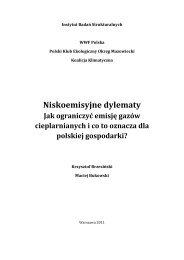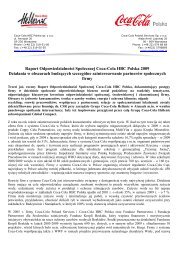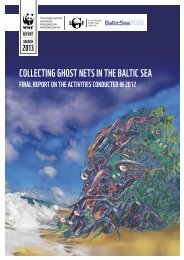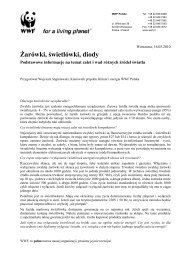Preserve Natural CapitalNatural capital – biodiversity, ecosystems <strong>and</strong> ecosystem services– must be preserved <strong>and</strong> restored as the foundation of humansocieties <strong>and</strong> economies. Efforts must particularly focus onprotecting <strong>and</strong> restoring key ecological processes necessary for food,water <strong>and</strong> energy security, as well as climate change resilience <strong>and</strong>adaptation. The Earth’s diversity of species <strong>and</strong> habitats must alsobe preserved for their intrinsic value.i. Significantly exp<strong>and</strong> the global protected areasnetwork• Protect 20 per cent of representative l<strong>and</strong>, freshwater <strong>and</strong>marine areas, including areas key for ecological processesnecessary for biodiversity, food, water <strong>and</strong> energy security,<strong>and</strong> climate change resilience <strong>and</strong> adaptation.• Implement adequate funding mechanisms for effectiveprotected area management.Halting forest degradation <strong>and</strong> deforestationAchieving Zero Net Deforestation <strong>and</strong> Degradation (ZNDD)would not only stem the depletion of forest-based biodiversity<strong>and</strong> ecosystem services, but also eliminate the second-largestsource of anthropogenic greenhouse gas emissions. WWFadvocates ZNDD by 2020 to reflect the scale <strong>and</strong> urgency ofthese threats.WWF defines ZNDD as: no net forest loss throughdeforestation <strong>and</strong> no net decline in forest quality throughdegradation; <strong>and</strong> stresses that: (a) most natural forest shouldbe retained – the annual rate of loss of natural or semi-naturalforests should be reduced to near zero; <strong>and</strong> (b) any gross loss ordegradation of pristine natural forests would need to be offsetby an equivalent area of socially <strong>and</strong> environmentally soundforest restoration.WWF’s Living Forests Model projects that it is possibleto achieve ZNDD by 2020, <strong>and</strong> warns that the longer it takes toachieve this goal the harder it will become to stem forest loss.But major changes in l<strong>and</strong> <strong>and</strong> resource use will be needed; theimplications <strong>and</strong> options for this are explored in WWF’s LivingForests Report (WWF, 2011a; b; c).Efforts must focuson protecting<strong>and</strong> restoring keyecological processesnecessary for food,water <strong>and</strong> energysecurity, as wellas climate changeresilience <strong>and</strong>adaptationii. Halt loss of priority habitats• Achieve Zero Net Deforestation <strong>and</strong> Degradation by 2020 <strong>and</strong>maintain thereafter.• Halt fragmentation of freshwater systems.• Increase the area of effectively managed marine protected areasfrom 5 per cent to at least 20 per cent.iii. Restore damaged ecosystems <strong>and</strong>ecosystem services• Prioritize restoration of ecosystems <strong>and</strong> ecosystem servicesnecessary for food, water <strong>and</strong> energy security, <strong>and</strong> climatechange resilience <strong>and</strong> adaptation.Water reserves: Securing water resources forpeople <strong>and</strong> natureThe Mexican National Water Commission(CONAGUA), with support from WWF <strong>and</strong> the FundacionGonzalo Río Arronte, is working to manage freshwaterecosystems. In 2011, a national environmental flow st<strong>and</strong>ardwas approved, <strong>and</strong> 189 basins were identified as potential “waterreserves”: watersheds with high biological richness <strong>and</strong> relativelyhigh water availability. These basins are the main targets of theNational Water Reserves Program (CONAGUA, 2011) that iscreating conditions to safeguard the natural flow regimes thatsustain critical ecosystems, secure the services they support<strong>and</strong> maintain buffering capacity against climate uncertainty<strong>and</strong> water scarcity risk.WWF Living Planet Report 2012 page 110 Chapter 4: Better <strong>choices</strong> for a living planet page 111
Produce <strong>better</strong>Efficient production systems would help lower humanity’sEcological Footprint to within ecological limits by significantlyreducing human dem<strong>and</strong> for water, l<strong>and</strong>, energy <strong>and</strong> other naturalresources. This is especially urgent in light of the growing humanpopulation <strong>and</strong> the need to meet the needs of the world’s poor. Suchsystems must manage food, fibre, energy <strong>and</strong> water in an integratedmanner, <strong>and</strong> ensure that sustainability is no longer a choice, butembedded into every commodity, product <strong>and</strong> process.iv. Significantly reduce inputs <strong>and</strong> waste inproduction systems• Increase total food supply-chain efficiency.• Maximize energy, water <strong>and</strong> material efficiency.• Maximize recycling <strong>and</strong> recovery.• Minimize greenhouse gas emissions.A new energy paradigmIn order for the world to stay below 2°C of warming – <strong>and</strong> so avoiddangerous climate change – global greenhouse gas emissions mustbe reduced to no more than 80 per cent of 1990 levels by 2050.The energy sector is key to achieving this goal. WWF’sEnergy Report presents one of the possible pathways towardachieving a cost-effective energy system, based wholly on renewableenergy (WWF, 2011d). The report raises a number of significantissues <strong>and</strong> challenges – political, economic, environmental <strong>and</strong>social – that will need to be addressed in order to realize thisenergy vision <strong>and</strong> minimize the impact of using more bioenergy.Better cotton in PakistanPakistan is the world’s third-largest producer of cotton, whichcontributes 55 per cent of its foreign earnings. 40,000 farmers inPakistan are now growing cotton with help from the Better CottonInitiative – a programme initiated by WWF <strong>and</strong> IKEA in 2006 toreduce the severe environmental impacts of conventional cottonproduction. In 2010, 170,000 hectares of cotton production utilized40 per cent less chemical fertilizers, 47 per cent less pesticides <strong>and</strong>37 per cent less water. <strong>Biodiversity</strong> was not the only beneficiary.While yields remained the same, farmers received a 15 per centincrease in income <strong>and</strong> their working conditions improvedsubstantially. Support for the initiative came from Levi Strauss<strong>and</strong> Co, H&M, Adidas <strong>and</strong> Marks & Spencer (WWF, 2003).Efficient productionsystems would helplower humanity’sEcologicalFootprint to withinecological limitsv. Manage resources sustainably• Eliminate overfishing by commercial fleets, including theindiscriminate capture of non-target organisms.• Eliminate water over-abstraction.• Implement policies to secure water quality.• Minimize further habitat conversion through maximizingthe sustainable use of productive l<strong>and</strong> by improvinggenetic selection, adopting best practices, increasingefficiency, improving soil organic matter <strong>and</strong> rehabilitatingdegraded l<strong>and</strong>s.vi. Scale-up renewable energy production• Increase the proportion of sustainable renewable energies inthe global energy mix to at least 40 per cent by 2030 <strong>and</strong> 100per cent by 2050.• Increase the share of renewable energy in the overall energymix, along with ambitious energy dem<strong>and</strong> management,especially in sectors with limited renewable options that arelikely to be dependent on bioenergy. (Aviation, shipping <strong>and</strong>high heat industrial applications are likely to be among these.)Certification in ChileChile currently has one of the strongest economies in Latin America,with projections suggesting that it could meet OECD criteria fordeveloped countries by 2020. It supplies 8 per cent of the globalpulp <strong>and</strong> paper market. To avoid large environmental impacts <strong>and</strong>depletion of natural resources, fundamental <strong>choices</strong> are needed totransform the forestry sector <strong>and</strong> enable Chile to continue to supplypulp <strong>and</strong> paper in a more environmentally <strong>and</strong> socially sustainableway. The rising global dem<strong>and</strong> for Forest Stewardship Council(FSC) certified paper is contributing to this transformation. WWF istherefore working closely with the forestry sector <strong>and</strong> the governmentof Chile to strengthen <strong>and</strong> broaden the scope of FSC certification.Similar developments are underway in Chile’s oceans <strong>and</strong> lakes.Chile is an important exporter of fish: It accounts for around 30 percent of the global salmon market, 13 per cent of the global market forforage fish; <strong>and</strong> 3 per cent of the global market for whitefish. MarineStewardship Council (MSC) certification is an important mechanismto tackle the current overexploitation of the Chilean fisheries <strong>and</strong> toachieve both environmentally sustainable <strong>and</strong> economically viablefisheries. The Chilean hake fishery has recently become the first toenter the MSC certification process. The Chilean salmon industry isworking with WWF in developing Aquaculture Stewardship Council(ASC) st<strong>and</strong>ards for sustainable salmon farming.WWF Living Planet Report 2012 page 112 Chapter 4: Better <strong>choices</strong> for a living planet page 113



